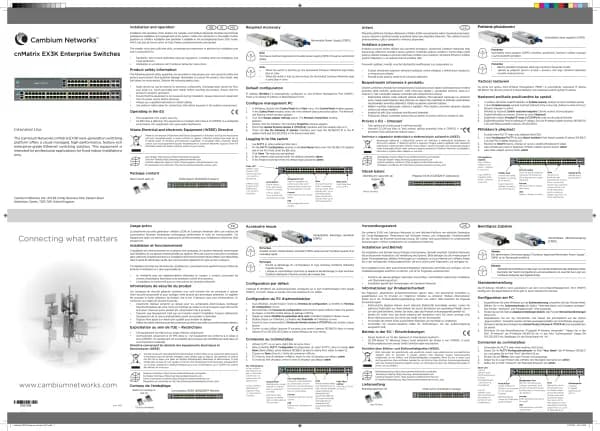Cambium Networks cnMatrix EX2028 handleiding
Handleiding
Je bekijkt pagina 112 van 320

L2 Features 112
priority) or via an ACL. A policy can then be applied to that class to enforce a certain traffic profile. In the
same manner, a meter can be applied to a class and have the corresponding traffic policed.
QoS provides means of doing the following:
l
Traffic policing on ingress and egress.
l
Priority remarking - via priority maps or via traffic policers.
l
Class-based queueing and scheduling.
l
Traffic shaping.
l
Traffic policing is a process applied to a flow of traffic that enforces configured parameters
regarding the maximum throughput for that flow. In this context, a traffic flow is an ACL-based
class, to which a policy containing a meter is applied. Traffic policing acts on ingress or egress
traffic, according to the way the ACL was configured.
Feature Overview
A meter is used to classify packets into three conformance levels: Green, Yellow, and Red. Traffic that is
below the committed information rate is considered conforming, and marked as Green. Traffic that is
over the committed information rate, but still conforming to a committed burst size is considered
“exceeding” or yellow. Traffic non-conforming to the meter is called violating and it is marked Red. The
configured policy determines then what actions should be applied on the packet, depending on this
conformance level: allow, remark its priority, or drop.
l
Priority remarking allows packets to have their dot1p priority or IP DSCP priority field modified by
being remapped to a “regenerated” value. When a packet has its dot1p priority remarked, it will be
queued according to the new “regenerated” priority. Priority remarking is accomplished via a
“priority map”, whichis a system-wide setting,therefore, a configured priority map will be by
default applied to all ports.
Toconfigure which priority information should be used as an input for the QoS application and the
priority remapping mechanism, the qos trust mode has to be selected. The user can configure QoS trust
mode as none, in which case the packet is assigned the port’s default dot1p priority regardless of any
priority information in the packet, or he can select dot1p and DSCP. This is a per-port setting.
Upon ingress, the switch needs to assign certain QoS properties to the packet. These properties will
determine what policies will be assigned to the packet, and, in the end, which queue of the egress port
will be used - how the packet will be scheduled, and which shapers will be applied.
These properties, which are initially assigned to the packet can be modified by configuring a class map,
which will use either priority maps or ACLs (dot1p priorities can be changed at this stage, and a traffic
class is assigned).
QoS properties can be re-assigned at the ingress stage by a policy map, which will use a meter to
determine the packet's compliance to a configure rate, according to the packet's traffic class.
The user can configure which data the switch should use to determine the initial QoS properties of a
packet:
l
Setting the trust mode to dot1p indicates that if a frame includes both 802.1p and a DSCP field,
then the pbit field takes precedence. If the frame does not include a 802.1p field, the ingress port's
priority is used to determine the packet's QoS properties.
Bekijk gratis de handleiding van Cambium Networks cnMatrix EX2028, stel vragen en lees de antwoorden op veelvoorkomende problemen, of gebruik onze assistent om sneller informatie in de handleiding te vinden of uitleg te krijgen over specifieke functies.
Productinformatie
| Merk | Cambium Networks |
| Model | cnMatrix EX2028 |
| Categorie | Niet gecategoriseerd |
| Taal | Nederlands |
| Grootte | 32421 MB |
Caratteristiche Prodotto
| Kleur van het product | Grijs |
| Gewicht | 2770 g |
| Breedte | 440 mm |
| Diepte | 209 mm |
| Hoogte | 44 mm |


